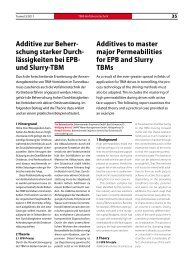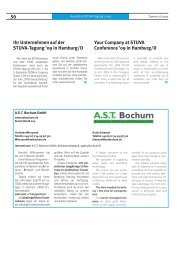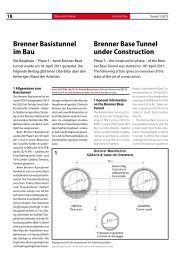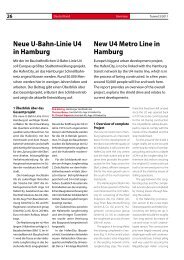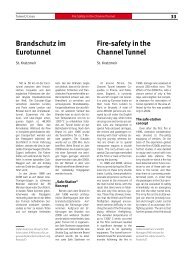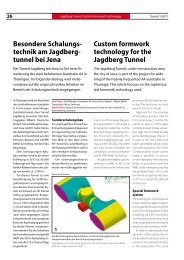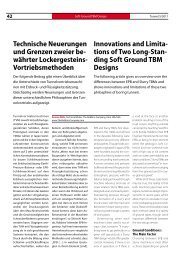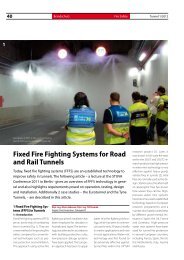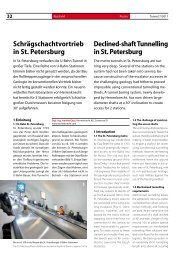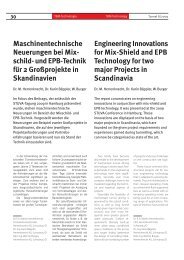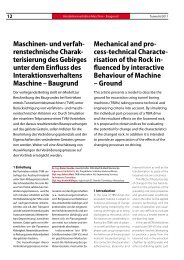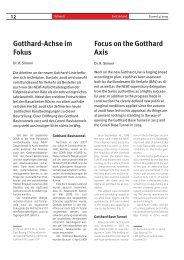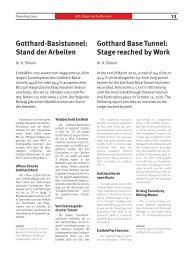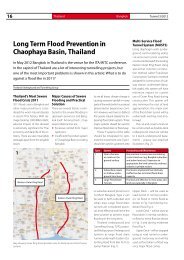U-Bahnbau im Brennpunkt der City - Tunnel
U-Bahnbau im Brennpunkt der City - Tunnel
U-Bahnbau im Brennpunkt der City - Tunnel
Erfolgreiche ePaper selbst erstellen
Machen Sie aus Ihren PDF Publikationen ein blätterbares Flipbook mit unserer einzigartigen Google optimierten e-Paper Software.
34 Deutschland<br />
Germany<br />
<strong>Tunnel</strong> 6/2012<br />
U-<strong>Bahnbau</strong> <strong>im</strong> <strong>Brennpunkt</strong><br />
<strong>der</strong> <strong>City</strong><br />
Die Landeshauptstadt Düsseldorf, in <strong>der</strong> Rangliste<br />
<strong>der</strong> Städte mit größter Lebensqualität hoch<br />
bewertet, schickt sich an, in <strong>der</strong> Stadtgestaltung<br />
und Infrastruktur weitere Akzente zu setzen.<br />
Zwei städtebauliche Großprojekte mitten in<br />
einer pulsierenden <strong>City</strong> mit einem Investitionsvolumen<br />
von mehr als 1 Mrd. Euro sind selbst<br />
für eine Großstadt nicht alltägliche Ereignisse.<br />
Die neue U-Bahn Wehrhahn-Linie sowie das<br />
Kö-Bogen-Areal werden das Gesicht einer weiter<br />
wachsenden Metropole nachhaltig prägen. Das<br />
Ziel <strong>der</strong> ersten Etappe baulicher Umsetzung<br />
wurde pünktlich erreicht: die Vollendung <strong>der</strong> 3,4<br />
km langen <strong>Tunnel</strong>röhre, die Schwerpunkt dieser<br />
Veröffentlichung ist.<br />
Metro Construction in<br />
the Focus of the <strong>City</strong><br />
The regional capital of Düsseldorf, highly rated<br />
among the cities affording the greatest life<br />
quality, is engaged in setting further standards<br />
in terms of urban design and infrastructure.<br />
Two major construction projects in a vibrant city<br />
involving an invested volume of more than<br />
1 billion euros are no everyday occurrences<br />
even for a place the size of Düsseldorf. The new<br />
Metro Wehrhahn Line and the Kö-Bogen area<br />
will sustainably place their stamp on an ever<br />
growing metropolis. The target of the first stage<br />
of the construction programme has been reached<br />
according to schedule: the completion of<br />
the 3.4 km long tunnel, which is the main topic<br />
dealt with in this report.<br />
In Düsseldorf leben mehr als<br />
580.000 Bürgerinnen und Bürger.<br />
In den unterschiedlichsten<br />
Branchen sind mehr als 450.000<br />
Menschen beschäftigt. Um die<br />
Attraktivität <strong>der</strong> Stadt für Wirtschaft<br />
und Handel zu bewahren,<br />
ist es erfor<strong>der</strong>lich, den Individualverkehr<br />
und den ÖPNV<br />
für den täglichen Zustrom an<br />
Pendlern zu opt<strong>im</strong>ieren. Unter<br />
dem Motto „Mehr Mobilität<br />
– mehr Stadtqualität“ ergänzt<br />
die neue U-Bahn-Strecke das<br />
bisherige Netz des öffentlichen<br />
Nahverkehrs und sorgt für eine<br />
attraktive Verbindung zwischen<br />
den östlichen und südlichen<br />
Stadtteilen. Die Baukosten belaufen<br />
sich auf insgesamt rd.<br />
748 Mio. Euro einschließlich<br />
Planungskosten und Grun<strong>der</strong>werb.<br />
Durch die Kombination<br />
von Technologien, architektonischen<br />
und künstlerischen<br />
Konzepten soll die Wehrhahn-<br />
Linie ein markantes Zeichen<br />
Andrea Blome, Amtsleiterin, Amt für Verkehrsmanagement <strong>der</strong> Landeshauptstadt<br />
Düsseldorf, andrea. blome@duesseldorf.de<br />
G. Wittkötter, Projektleiter Wehrhahn-Linie, Amt für Verkehrsmanagement<br />
<strong>der</strong> Landeshauptstadt Düsseldorf, gerd.wittkoetter@duesseldorf.de<br />
B. Ferrière, Projektleiter Wehrhahn-Linie Los 1, Bilfinger Berger Ingenieurbau<br />
GmbH, benno.ferriere@civil.bilfinger.de<br />
setzen und zu den mo<strong>der</strong>nsten<br />
und benutzerfreundlichsten<br />
U-Bahnstrecken Europas gehören.<br />
Immerhin werden hier<br />
täglich mehr als 50.000 Fahrgäste<br />
erwartet, die in Zukunft<br />
allein durch den Wegfall von<br />
5 Straßenbahnlinien schneller<br />
und komfortabler ihre Ziele<br />
erreichen sollen.<br />
Die U-Bahn-Trasse unterquert<br />
die Düsseldorfer <strong>City</strong><br />
und damit einen für Anwohner,<br />
Geschäftsleute sowie die<br />
Verkehrsführung äußerst sensiblen<br />
Bereich. Die Untertunnelung<br />
einer Innenstadt auf<br />
mehreren Kilometern sowie <strong>der</strong><br />
gleichzeitige Bau von 6 neuen<br />
unterirdischen Bahnhöfen sind<br />
Vorhaben, die an den betrof-<br />
Düsseldorf has more than<br />
580,000 inhabitants. More than<br />
450,000 people find employment<br />
in the various branches of<br />
industry and commerce. It is essential<br />
to opt<strong>im</strong>ise private motoring<br />
and public commuter transportation<br />
to ensure that the city<br />
remains attractive for business.<br />
With the slogan “More Mobility<br />
– more Urban Quality” the new<br />
Metro line augments the existing<br />
transit network catering for an efficient<br />
link between the eastern<br />
and western parts of the city.<br />
The construction costs amount<br />
to a total of some 748 million<br />
euros including planning costs<br />
and land acquisition. Through<br />
combining technologies, architectural<br />
and artistic concepts,<br />
the Wehrhahn Line is destined<br />
to set standards making it one<br />
of Europe’s most mo<strong>der</strong>n and<br />
user-friendly Metro lines. After all<br />
no less than 50,000 passengers<br />
are expected to use the facility<br />
on a daily basis, who will arrive<br />
at their destinations faster and<br />
more comfortably thanks to the<br />
scrapping of 5 tram lines.<br />
The Metro route un<strong>der</strong>cuts<br />
downtown Düsseldorf – an extremely<br />
critical area for residents,<br />
business people and the traffic<br />
set-up. Un<strong>der</strong>tunnelling a city<br />
centre over several kilometres<br />
as well as the construction of<br />
6 new un<strong>der</strong>ground stations<br />
are projects, which do not go<br />
unnoticed by the citizens who<br />
are affected. Well before the<br />
individual planning phases began<br />
right up until the first clod<br />
of earth was turned the Office<br />
for Transport Management responsible<br />
for the entire project<br />
had recognised the necessity
<strong>Tunnel</strong> 6/2012<br />
Wehrhahn-Linie in Düsseldorf<br />
35<br />
Blick in die fertig gestellte <strong>Tunnel</strong>röhre<br />
View of the completed tunnel bore<br />
fenen Bürgern nicht kommentarlos<br />
vorbeigehen dürfen.<br />
Schon lange vor Beginn <strong>der</strong><br />
einzelnen Planungsphasen bis<br />
hin zum ersten Spatenstich hatte<br />
das für das Gesamtprojekt<br />
verantwortliche Amt für Verkehrsmanagement<br />
die Zeichen<br />
<strong>der</strong> Zeit erkannt und unter dem<br />
Motto Agieren statt Reagieren<br />
den „proaktiven Dialog“ mit allen<br />
von den Baumaßnahmen<br />
Betroffenen gesucht und weitestgehend<br />
umfeld- und umweltverträgliche<br />
Lösungen für<br />
die Realisierung <strong>der</strong> Baumaßnahmen<br />
gefunden. Oberstes<br />
Ziel war, die betroffenen Bürger<br />
vor allzu schwerwiegenden<br />
Einschränkungen zu schützen<br />
und die gesamten Verkehrsbeziehungen<br />
des Individual- und<br />
öffentlichen Personennahverkehrs<br />
während <strong>der</strong> gesamten<br />
Bauzeit aufrecht zu erhalten.<br />
Deshalb galt es, sich auf Bauverfahren<br />
zu konzentrieren, die<br />
weitestgehend unter <strong>der</strong> Erde<br />
stattfinden und sich bei in Düsseldorf<br />
vorangegangenen U-<br />
Bahnstrecken bereits bewährt<br />
haben: <strong>der</strong> Schildvortrieb auf<br />
<strong>der</strong> Strecke und die „Düsseldorfer<br />
Deckelbauweise“ <strong>im</strong> Bereich<br />
<strong>der</strong> 6 neuen Bahnhöfe.<br />
Diffizile Kanalverlegung<br />
vor dem U-<strong>Bahnbau</strong><br />
Vor Beginn <strong>der</strong> eigentlichen<br />
<strong>Tunnel</strong>bauarbeiten hatten Planer,<br />
Kanal- und- Leitungsbauer<br />
eine anspruchsvolle unterirdische<br />
Infrastrukturmaßnahme<br />
zu bewältigen: die Verlegung<br />
bzw. Erneuerung des <strong>im</strong> Innenstadtbereich<br />
dichten und<br />
sensiblen Leitungsnetzes ohne<br />
größere Verkehrsstörungen<br />
vor allem in den Fußgängerbereichen<br />
zu verursachen. An<br />
einigen Stellen mussten komplette<br />
Kanalabschnitte dem<br />
and established a “pro-active<br />
dialogue” un<strong>der</strong> the motto “acting<br />
rather than reacting” with<br />
all those affected by the construction<br />
scheme. Towards this<br />
end solutions compatible with<br />
the environment were sought in<br />
or<strong>der</strong> to accomplish the construction<br />
measures. The priority<br />
was to protect those affected<br />
from excessive restrictions and<br />
to maintain the entire traffic<br />
set-up for private and public<br />
transportation as far as possible<br />
throughout the construction<br />
process. As a consequence it<br />
was essential to concentrate on<br />
construction methods, which<br />
were mainly carried out un<strong>der</strong>ground<br />
and which had already<br />
proved their worth during the<br />
building of previous Metro lines<br />
in Düsseldorf: shield driving for<br />
the route and the “Düsseldorf<br />
dig-and-cast method” for the 6<br />
new stations.<br />
Difficult Laying of Utilities<br />
prior to Constructing<br />
the Metro<br />
Before the actual tunnelling<br />
began planners and utility line<br />
contractors had to accomplish<br />
a sophisticated un<strong>der</strong>ground<br />
infrastructure measure: the laying<br />
and upgrading of the dense<br />
and sensitive line network in the<br />
downtown area without causing<br />
major hindrances to traffic above<br />
all in the pedestrian zones. At<br />
some spots complete sections of<br />
sewers had to make way for the<br />
Metro or be relocated from their<br />
original position in the middle of<br />
the road to along house fronts.<br />
Towards this end extensive un<strong>der</strong>pinning<br />
work was necessary<br />
at the adjoining buildings mainly<br />
using the jet grouting method.<br />
Some 4 km of water and sewer<br />
lines were produced. A whole<br />
range of pipes varying between<br />
300 and 2,200 mm in diameter
36 Deutschland<br />
Germany <strong>Tunnel</strong> 6/2012<br />
U-<strong>Bahnbau</strong> weichen bzw. von<br />
ihrer ursprünglichen Lage in<br />
<strong>der</strong> Straßenmitte entlang <strong>der</strong><br />
Hausfronten verlegt werden.<br />
Dafür waren auch umfängliche<br />
Unterfangungsarbeiten an den<br />
angrenzenden Gebäuden <strong>im</strong><br />
Wesentlichen <strong>im</strong> Düsenstrahlverfahren<br />
notwendig. Rund<br />
4 km Wasser- und Abwasserkanäle<br />
entstehen neu. Dafür<br />
war eine ganze Palette von<br />
Rohren mit Durchmessern von<br />
300 bis 2.200 mm notwendig.<br />
Auf eine Gesamtlänge von 100<br />
km addieren sich die Leitungen<br />
für Strom, Wasser, Gas, Fernwärme<br />
usw., die es zu verlegen galt.<br />
Be<strong>im</strong> Bau <strong>der</strong> U-Bahntrasse<br />
machte dies einen großen Anteil<br />
<strong>der</strong> Gesamtleistung aus.<br />
Umweltverträgliche<br />
Bauverfahren beson<strong>der</strong>s<br />
be<strong>im</strong> Tunelbau<br />
gefragt<br />
In Düsseldorf begann das<br />
<strong>Tunnel</strong>bau-Zeitalter bereits<br />
<strong>im</strong> Jahre 1958/59, als es<br />
galt, die Abwasserkanäle <strong>der</strong><br />
rechtsrheinischen Stadtgebiete<br />
mit <strong>der</strong> linksrheinischen<br />
Kläranlage unter dem Rhein<br />
zu verbinden. Eine Pioniertat:<br />
Die Stadtväter hatten<br />
sich entschlossen, den dafür<br />
notwendigen <strong>Tunnel</strong> <strong>im</strong><br />
Druckluft-Schildvortrieb aufzufahren,<br />
einem umweltschonenden<br />
Verfahren, das zuvor<br />
in Deutschland noch nicht<br />
angewandt worden war. Den<br />
U-Bahn-Ausbau betreibt man<br />
in <strong>der</strong> Landeshauptstadt seit<br />
mehr als 4 Jahrzehnten. Es<br />
existieren bereits <strong>Tunnel</strong> von<br />
insgesamt rd. 7 km Länge.<br />
Bei <strong>der</strong> Planung <strong>der</strong> neuen<br />
U-Bahn-Trasse war man bestrebt,<br />
die Auswirkungen <strong>der</strong><br />
Bauarbeiten inmitten einer<br />
stark frequentierten Innenstadt<br />
auf ein Mindestmaß zu<br />
Trassenverlauf <strong>der</strong> bestehenden U-Bahn-Strecken sowie <strong>der</strong> neuen Wehrhahn-Linie<br />
(rote Markierung)<br />
Route alignment of the existing Metro lines as well as the new Wehrhahn Line<br />
(red marking)<br />
Die Grafik verdeutlicht das engmaschige Leitungs- und Kanalnetz <strong>im</strong> Zuge<br />
<strong>der</strong> neuen U-Bahn-Strecke und gleichzeitig, wie groß <strong>der</strong> Aufwand ist, wenn<br />
in eine solche Kreuzung ein U-Bahnhof platziert wird<br />
The diagram displays the tightly-knit pipe and sewer network in conjunction<br />
with the new Metro line and at the same t<strong>im</strong>e just how complex it is to set up a<br />
Metro station at such an intersection<br />
beschränken. Der unterirdische<br />
Schildvortrieb, <strong>der</strong> bereits bei<br />
früheren Streckenabschnitten<br />
erfolgreich angewandt wurde,<br />
erwies sich als die einzig sinnvolle<br />
und auch wirtschaftlich<br />
was applied. With the lines for<br />
electricity, water, gas, district heating<br />
etc. that had to be laid, the<br />
grand total amounted to 100 km.<br />
This accounted for a major portion<br />
of the overall performance.<br />
Environmentallyfriendly<br />
Construction<br />
Methods particularly<br />
sought for <strong>Tunnel</strong>ling<br />
The age of tunnelling in Düsseldorf<br />
began as far back as 1958/59<br />
when the sewers of the parts of<br />
the city on the right bank of the<br />
Rhine had to be linked with the<br />
clarification plant on the left bank<br />
beneath the river. A trail-blazing<br />
enterprise: the city fathers decided<br />
to have the necessary tunnel<br />
produced using a compressed<br />
air shield drive, an environmentally-friendly<br />
method, which<br />
had never before been applied<br />
in Germany. Metro construction<br />
has forged ahead in the regional<br />
capital for more than 4 decades.<br />
<strong>Tunnel</strong>s totalling in excess of 7<br />
km have been built.<br />
To construct the new Metro<br />
route an effort was made at the<br />
planning stage to restrict the effects<br />
of the construction work in<br />
the middle of an extremely busy<br />
downtown area to a min<strong>im</strong>um.<br />
The un<strong>der</strong>ground shield drive,<br />
which was applied successfully for<br />
former route sections, emerged as<br />
the sole sensible and also economically<br />
viable alternative and was<br />
made use of along the entire route<br />
in modified form. A part-section<br />
that was built in advance more<br />
than 30 years ago led to the tunnel<br />
being created in 2 sections.<br />
Temporary construction pits<br />
were required only at the 6 new<br />
stations, 5 of which were produced<br />
by dig-and-cast. The graphic<br />
diagram shows the procedure:<br />
firstly diaphragm walls are set<br />
up in a longitudinal direction,<br />
then the top section of the future<br />
station is built, un<strong>der</strong> which<br />
the further construction activities<br />
take place. Traffic in then<br />
conducted past the site so that<br />
it can continue to flow. In this<br />
way restrictions are confined to<br />
a min<strong>im</strong>um. Subsequently the
<strong>Tunnel</strong> 6/2012<br />
Wehrhahn Line in Düsseldorf<br />
37<br />
„Umfeld-freundliches“ Bauprinzip für die neuen unterirdischen Bahnhöfe mit modifiziertem Schildvortrieb und bewährter Deckelbauweise<br />
“Environmentally-friendly” construction principle for the new un<strong>der</strong>ground stations with modified shield drive and tried-and-tested dig-and-cast method<br />
vertretbare Alternative und<br />
wurde auf <strong>der</strong> gesamten Strecke<br />
in modifizierter Bauweise<br />
realisiert. Ein vor über 30 Jahren<br />
bereits vorgezogen erstellter<br />
Teilabschnitt führte zur Erstellung<br />
<strong>der</strong> <strong>Tunnel</strong>röhre in 2 Abschnitten.<br />
Lediglich in den Bereichen <strong>der</strong><br />
6 neuen Bahnhöfe, von denen<br />
5 in Deckelbauweise errichtet<br />
wurden, waren temporäre Baugruben<br />
erfor<strong>der</strong>lich. Die grafische<br />
Darstellung vermittelt<br />
den Bauablauf: Zunächst werden<br />
in Längsrichtung Schlitzstations<br />
are developed entirely<br />
un<strong>der</strong>ground. Project-specific<br />
demands had to be fulfilled<br />
and progressive construction<br />
techniques applied efficiently<br />
for driving and supporting the<br />
tunnel. As a result tunnellers and<br />
construction material technologists<br />
were called on to develop<br />
new know-how and innovative<br />
concrete cast parts.<br />
<strong>Tunnel</strong> Segments with<br />
utmost Precision<br />
The DW-Werk Nievenhe<strong>im</strong> of<br />
the Berding Beton GmbH pos-<br />
Bergbau, <strong>Tunnel</strong>bau – Mining, <strong>Tunnel</strong>ling<br />
TH-, GI-, HEB- und Sternprofile<br />
TH-, GI-, HEB- and Star-Profile<br />
2-, 3- und 4-Gurt-Gitterträger<br />
2-, 3- and 4-bar Lattice Gir<strong>der</strong><br />
Son<strong>der</strong>konstruktionen für Großräume<br />
Special Construction for big excavation areas<br />
Verstellbarer, nachgiebiger Tübbingausbau<br />
Yieldable, adjustable Tubbing Support<br />
DSK Schmidt<br />
DSK Schmidt<br />
Ankersysteme – Bolting System<br />
Jackpots und Donuts – Jackpots and Donuts<br />
Stauchelemente – Stress Controller<br />
Wärmebehandlung – Heat Treatment<br />
Alp Transit Gotthard AG<br />
Klosterstraße 46 . 44787 Bochum, GERMANY . Tel.: + 49 (0) 234 - 9118 - 0<br />
Fax: + 49 (0) 234 - 9118 - 228 www.be-heico.de . email: info@be-heico.de
38 Deutschland<br />
Germany <strong>Tunnel</strong> 6/2012<br />
sesses long-standing experience<br />
in producing high-quality reinforced<br />
concrete cast parts quite<br />
apart from a highly-efficient<br />
mo<strong>der</strong>n production line for reinforced<br />
concrete segments. This<br />
is why it was commissioned by<br />
the Bilfinger Berger Ingenieurbau<br />
GmbH as general contractor<br />
to produce the reinforced<br />
concrete segments for lining<br />
the tunnel bores. They possess<br />
an external diameter of 9.20<br />
m. Each tunnel ring consists of<br />
7+1 segments, each weighing<br />
6.6 t. An entire ring weighs 46.2<br />
t. Altogether 12,144 individual<br />
elements were produced – resulting<br />
in a total of 1,518 rings<br />
for the 2 construction sections.<br />
The concrete rings were produced<br />
with a conic form.<br />
Innovative Steel Fibre<br />
Technology successfully<br />
applied<br />
The segments in the station areas<br />
comprise a steel fibre concrete,<br />
which facilitated precision down<br />
to tenths of a mill<strong>im</strong>etre in conjunction<br />
with a special shuttering<br />
method. Towards this end, a special<br />
multi-tested concrete recipe<br />
as well as the utmost accuracy<br />
during the production process<br />
was essential. A report provided<br />
by the Bilfinger Berger Ingenieurbau<br />
(by Dipl.-Ing. Lars Bayer and<br />
Dipl.-Ing. Markus Brack) supplied<br />
invaluable findings, which can<br />
by and large be summed up as<br />
follows:<br />
• The manifold possibilities for<br />
applying concrete can be consi<strong>der</strong>ably<br />
extended by using<br />
Direkt neben <strong>der</strong> neuen U-Bahn-Trasse musste ein 4 km langes, weitläufiges<br />
Kanalnetz aus Hochleistungs-Stahlbetonrohren verlegt werden, oft<br />
unmittelbar entlang <strong>der</strong> Häuserfronten<br />
A 4 km long, extensive sewer network consisting of high-grade reinforced<br />
concrete pipes had to be laid directly alongside the new Metro route, often<br />
along the house fronts<br />
wände angelegt, dann <strong>der</strong> Deckel<br />
des künftigen Bahnhofs<br />
gebaut, unter dem sich auch<br />
die weiteren Bauaktivitäten<br />
abspielen. An <strong>der</strong> Oberfläche<br />
wird <strong>der</strong> Verkehr an <strong>der</strong> Baustelle<br />
vorbeigeführt und kann<br />
so weiter fließen. Beeinträchtigungen<br />
hielten sich so in Grenzen.<br />
Der gesamte Ausbau <strong>der</strong><br />
Bahnhöfe erfolgte anschließend<br />
durchweg unterirdisch.<br />
Für Vortrieb und <strong>Tunnel</strong>ausbau<br />
galt es, projektspezifische Anfor<strong>der</strong>ungen<br />
zu erfüllen und<br />
fortschrittliche Techniken effizient<br />
umzusetzen. Dafür waren<br />
<strong>Tunnel</strong>bauer und Baustofftechnologen<br />
gleichermaßen<br />
gefor<strong>der</strong>t, neues Know-how<br />
sowie innovative Betonfertigteile<br />
zu entwickeln.<br />
<strong>Tunnel</strong>-Tübbinge mit<br />
höchster Präzision<br />
Ein reicher Erfahrungsschatz<br />
in <strong>der</strong> Produktion hochwertiger<br />
Stahlbeton-Fertigteile<br />
sowie die Leistungsfähigkeit<br />
einer neuen, mo<strong>der</strong>nen Produktionslinie<br />
für Stahlbeton-<br />
Tübbinge waren für Bilfinger<br />
Berger Ingenieurbau GmbH<br />
als Generalunternehmer ausschlaggebend,<br />
das DW-Werk<br />
Nievenhe<strong>im</strong> <strong>der</strong> Berding Beton<br />
GmbH mit <strong>der</strong> Produktion <strong>der</strong><br />
Stahlbeton-Tübbinge für den<br />
Ausbau <strong>der</strong> <strong>Tunnel</strong>röhren zu<br />
beauftragen. Sie haben einen<br />
Außendurchmesser von 9,20 m.<br />
Je<strong>der</strong> <strong>Tunnel</strong>ring besteht aus<br />
7+1 Tübbingen mit einem Gewicht<br />
von je 6,6 t. Der gesamte<br />
Ring wiegt 46,2 t. Insgesamt
<strong>Tunnel</strong> 6/2012<br />
Wehrhahn-Linie in Düsseldorf<br />
wurden 12.144 Einzelelemente<br />
produziert, die für beide Bauabschnitte<br />
insgesamt 1.518<br />
Ringe ergaben. Die Betonringe<br />
wurden konisch hergestellt.<br />
Innovative Stahlfaser-<br />
Technologie erfolgreich<br />
umgesetzt<br />
Die Tübbinge in den Bahnhofsbereichen<br />
bestehen aus<br />
einem Stahlfaserbeton, <strong>der</strong> in<br />
Verbindung mit einem speziellen<br />
Schalungsverfahren eine<br />
erwartete Maßgenauigkeit <strong>im</strong><br />
Zehntel-Mill<strong>im</strong>eter-Bereich ermöglichte.<br />
Dafür waren eine<br />
beson<strong>der</strong>e, mehrfach geprüfte<br />
Betonrezeptur sowie äußerste<br />
Präzision <strong>im</strong> Produktionsablauf<br />
unabdingbare Voraussetzung.<br />
In einem Bericht <strong>der</strong> Bilfinger<br />
fibres especially steel fibres in<br />
the mix. This now also applies<br />
for segments, thus opening<br />
up an interesting market sector.<br />
• Steel fibres included and<br />
evenly distributed in the<br />
concrete mix <strong>im</strong>prove the<br />
properties by counteracting<br />
crack formation as 3-d<strong>im</strong>ensional<br />
evenly distributed<br />
reinforcement and resist<br />
the tendency for cracks to<br />
expand. The crack edges are<br />
connected by the steel fibres.<br />
In this way residual bearing<br />
capacity is assured even in<br />
cracked state.<br />
• Furthermore steel fibre concrete<br />
represents an economic<br />
alternative, which is not<br />
only technically on par with<br />
Tübbing-Produktion am laufenden Band in einem mo<strong>der</strong>nen Fertigteilwerk<br />
Continuous production of segments in a mo<strong>der</strong>n pre-cast part factory
40 Deutschland<br />
Germany <strong>Tunnel</strong> 6/2012<br />
Gleichmäßig verteilte Stahlfasern für die temporären Tübbinge in den<br />
Bahnhofsbereichen<br />
Uniformly distributed steel fibres for the temporary segments at<br />
the stations<br />
Vermessung <strong>der</strong> Tübbing-Segmente zur Überprüfung <strong>der</strong> Einhaltung<br />
extrem enger Toleranzvorgaben von zum Teil max. 0,3 mm<br />
Measuring the ring segments to check whether the extremely strict tolerance<br />
parameters of in some cases max. 0.3 mm are adhered to<br />
Berger Ingenieurbau (von Dipl.-<br />
Ing. Lars Bayer und Dipl.-Ing.<br />
Markus Brack) gelangte man<br />
zu wertvollen Erkenntnissen,<br />
die <strong>im</strong> Wesentlichen wie folgt<br />
zusammengefasst werden<br />
können:<br />
• Die vielfältigen Anwendungsmöglichkeiten<br />
von<br />
Beton lassen sich durch den<br />
Einsatz von eingemischten<br />
Fasern, insbeson<strong>der</strong>e von<br />
Stahlfasern deutlich erweitern.<br />
Das gilt nun auch für<br />
Tübbinge, für die sich ein<br />
interessantes Marktsegment<br />
erschließt.<br />
• In die Betonmischung eingebrachte<br />
und gleichmäßig<br />
verteilte Stahlfasern verbessern<br />
die Eigenschaften,<br />
indem sie als dreid<strong>im</strong>ensional<br />
gleichmäßig verteilte<br />
Bewehrung <strong>der</strong> Rissbildung<br />
entgegen wirken und einer<br />
zunehmenden Rissaufweitung<br />
Wi<strong>der</strong>stand leisten.<br />
Die Rissufer sind durch die<br />
Stahlfasern miteinan<strong>der</strong> vernadelt.<br />
Dadurch bleibt selbst<br />
<strong>im</strong> gerissenen Zustand eine<br />
Resttragfähigkeit erhalten.<br />
• Stahlfaserbeton bietet ferner<br />
eine wirtschaftliche Alternative,<br />
die technisch nicht nur<br />
gleichwertig, son<strong>der</strong>n in<br />
vielen Belangen sogar besser<br />
als herkömmlicher Beton<br />
ist. Durch die gleichmäßige<br />
Verteilung <strong>der</strong> Fasern kann<br />
<strong>der</strong> Stahlfaserbeton als homogener<br />
und isotroper Baustoff<br />
Biegezug- und Spaltzugkräfte<br />
in je<strong>der</strong> beliebigen<br />
Richtung aufnehmen. Ein<br />
weiterer wesentlicher Vorteil<br />
ist <strong>der</strong> vereinfachte Produktionsablauf.<br />
Die aufwändigen<br />
Arbeitsschritte Bewehrungskorb-Herstellung,<br />
-Transport<br />
und -Einbau können entfallen.<br />
• In allen 4 Bahnhöfen, die<br />
von <strong>der</strong> TBM durchfahren<br />
wurden, hatte man Stahlfaserbeton-Tübbinge<br />
temporär<br />
eingesetzt und für eine<br />
Nutzungsdauer von 3 Jahren<br />
nach <strong>der</strong> neuen Deutschen<br />
Richtlinie Stahlfaserbeton<br />
bemessen. Basierend auf <strong>der</strong><br />
berechneten Leistungsklasse<br />
wurde von Bekaert eine Dramix-Stahlfaser<br />
RC-80/60-BN<br />
vorgeschlagen und durch<br />
Vorprüfungen <strong>im</strong> werkseigenen<br />
Labor bestätigt. Weitere<br />
Prüfungen erfolgten bei<br />
Bilfinger Berger und <strong>im</strong> DW-<br />
Werk Nievenhe<strong>im</strong>. Nach positiven<br />
Ergebnissen dieser Prüfungen<br />
folgten weitere von<br />
conventional concrete but<br />
is in many respects superior.<br />
Thanks to the uniform distribution<br />
of the fibres, steel<br />
fibre concrete is capable<br />
of sustaining bending and<br />
tensile forces in any desired<br />
direction as a homogeneous<br />
and isotropic construction<br />
material. A further substantial<br />
advantage is the straightforward<br />
means of production.<br />
There is no need for complicated<br />
working steps involving<br />
producing, transporting and<br />
installing reinforcing cages.<br />
• Steel fibre concrete segments<br />
were temporarily applied for<br />
all 4 stations crossed by TBM<br />
and d<strong>im</strong>ensioned for a period<br />
of use lasting 3 years in<br />
accordance with the new<br />
German Guideline on Steel<br />
Fibre Concrete. Based on the<br />
est<strong>im</strong>ated performance class,<br />
a Dramix Steel Fibre RC-80/60-<br />
BN was proposed by Bekaert<br />
and confirmed through tests<br />
in the company’s own lab.<br />
Further tests took place at Bilfinger<br />
Berger and in the DW-<br />
Werk Nievenhe<strong>im</strong>. After these<br />
tests revealed positive results,<br />
further trials were carried out<br />
at the TU Brunswick and the<br />
Institute for Construction Materials,<br />
Massive Construction<br />
and Fire Protection. These<br />
tests formed the basis for approval<br />
in each individual case<br />
and were included in a quality<br />
assurance plan especially developed<br />
for this construction<br />
scheme. The extremely good<br />
results obtained during the<br />
lab tests were confirmed by<br />
hardened concrete tests on<br />
the structure.<br />
• Following the introduction of<br />
the new Guideline on Steel Fibre<br />
Concrete in practice, innovative<br />
applications of steel<br />
fibre concrete – in general<br />
use worldwide now for years<br />
– should also be applied increasingly<br />
in Germany. However<br />
a lot of clarification and<br />
catching up is still essential in<br />
this respect. Details relating to<br />
verifying the stability of steel<br />
fibre reinforced concrete were<br />
dealt with at length by Dipl.-<br />
Ing. Max Kemmler (Bilfinger<br />
Berger Ingenieurbau) in the<br />
jubilee publication “Past meets<br />
Future – 50 Years of STUVA”.<br />
This led among others things<br />
to the conclusion “that verification<br />
of the ductile structural<br />
behaviour according to DIN<br />
1045-1 as well as verification<br />
of any shortfall of the system
<strong>Tunnel</strong> 6/2012<br />
Wehrhahn Line in Düsseldorf<br />
41<br />
<strong>der</strong> TU Braunschweig sowie<br />
dem Institut für Baustoffe,<br />
Massivbau und Brandschutz.<br />
Diese Prüfungen waren die<br />
Grundlage für eine Zust<strong>im</strong>mung<br />
<strong>im</strong> Einzelfall und flossen<br />
in einen speziell für dieses<br />
Bauvorhaben entwickelten<br />
Qualitätssicherungsplan ein.<br />
Die sehr guten Ergebnisse<br />
<strong>der</strong> Laborversuche konnten<br />
durch Festbetonprüfungen<br />
am Bauwerk durchweg bestätigt<br />
werden.<br />
• Durch die baurechtliche Einführung<br />
<strong>der</strong> neuen Stahlbeton-Richtlinie<br />
sollten innovative<br />
Anwendungen von<br />
Stahlfaserbeton – weltweit<br />
bereits seit Jahren Stand <strong>der</strong><br />
Technik – auch in Deutschland<br />
vermehrt genutzt werden.<br />
Hier besteht dafür jedoch<br />
noch ein erheblicher<br />
Aufklärungs- und Nachholbedarf.<br />
Einzelheiten über<br />
den Stabilitätsnachweis <strong>der</strong><br />
stahlfaserbewehrten Tübbinge<br />
wurden <strong>im</strong> Jubiläumsband<br />
„Vergangenheit trifft<br />
Zukunft – 50 Jahre STUVA“<br />
von Dipl.-Ing. Max Kemmler<br />
(Bilfinger Berger Ingenieurbau)<br />
ausführlich behandelt<br />
und u.a. festgestellt, „dass<br />
<strong>der</strong> Nachweis des duktilen<br />
Bauteileverhaltens nach DIN<br />
1045-1 bzw. <strong>der</strong> Nachweis<br />
einer Unterschreitung <strong>der</strong><br />
Systemtraglast mit nur geringfügigen<br />
Än<strong>der</strong>ungen <strong>im</strong><br />
statischen System und ohne<br />
großen Aufwand erbracht<br />
werden kann“.<br />
bearing load can be provided<br />
with only slight alterations to<br />
the static system and without<br />
major t<strong>im</strong>e and effort”.<br />
“Tuborine” produced<br />
Metro Lot in Record<br />
T<strong>im</strong>e<br />
The hydro-shield method was<br />
applied in Düsseldorf to excavate<br />
the soil and support the<br />
face. The approx. 2.3 km long<br />
drive was split into the individual<br />
contract sections south and est.<br />
The 1,298 m long south section<br />
mainly runs beneath the public<br />
road area, the 995 m long east<br />
drive partially un<strong>der</strong>neath existing<br />
buildings and beneath public<br />
roadways. The shield passed<br />
through the station areas. At this<br />
t<strong>im</strong>e point the diaphragm wall<br />
construction pit enclosures and<br />
the station top covers were already<br />
completed although the<br />
pit still had to be excavated and<br />
the groundwater lowered. Then<br />
the temporary tunnel segments<br />
were removed within the station<br />
sections and the roughwork for<br />
the stations could be tackled.<br />
The Herrenknecht Mixshield<br />
S-491 TBM, christened “Tuborine”<br />
by a Düsseldorf lady resident, was<br />
devised especially for the Metro<br />
Wehrhahn Line: a giant among<br />
tunnelling machine weighing<br />
1,302 t and 65 m long with 9.50<br />
m cutting wheel diameter. The<br />
115 t heavy cutting wheel that<br />
loosened the soil was located at<br />
the front of the cutterhead. The<br />
cutterhead penetrated the soil<br />
with the cutting wheel. Once<br />
Safety first!<br />
Baulicher Brandschutz mit<br />
maßgeschnei<strong>der</strong>ten Lösungen und<br />
überzeugendem Service.<br />
AESTUVER T – eine speziell für den Hochtemperaturbereich<br />
entwickelte Brandschutzplatte aus<br />
Glasfaserleichtbeton<br />
schützt Beton zuverlässig vor Brandbelastungen<br />
bis 1.350 °C.<br />
ist frost- und wasserbeständig.<br />
bietet vielfältige Gestaltungsmöglichkeiten mit<br />
Farben und Beschichtungen.<br />
Fire safety engineering with<br />
tailored solutions and convincing<br />
customer support.<br />
AESTUVER T – glass-fibre reinforced light-weight<br />
concrete boards specifically developed for hightemperature<br />
environments.<br />
Reliable protection for concrete against effects<br />
of fire loads of up to 1,350 °C.<br />
Frost and water resistant.<br />
Painting and coating options for customized<br />
finishes.<br />
Fermacell GmbH<br />
FERMACELL Aestuver<br />
Düsseldorfer Landstr. 395 · 47259 Duisburg<br />
Telefon: +49 (0) 203 60880-8141<br />
Telefax: +49 (0) 203 60880-8140<br />
E-Mail: info@aestuver.de<br />
www.aestuver.de
42 Deutschland<br />
Germany <strong>Tunnel</strong> 6/2012<br />
Montage des 115 t schweren Schneidrades <strong>der</strong> „Tuborine“ mit einem<br />
Durchmesser von 9,5 m<br />
Assembly of the 115 t heavy cutting wheel of the “Tuborine”<br />
with 9.5 m diameter<br />
„Tuborine“ schaffte U-<br />
Bahn-Los in Rekordzeit<br />
In Düsseldorf kam das Hydroschildverfahren<br />
zum Bodenabbau<br />
und Stützen <strong>der</strong> Ortsbrust<br />
zum Einsatz. Die reine Vortriebslänge<br />
von ca. 2,3 km teilt<br />
sich auf in die Einzelvortriebe<br />
Süd und Ost. Beide wurden<br />
nacheinan<strong>der</strong> mit <strong>der</strong>selben<br />
<strong>Tunnel</strong>vortriebsmaschine mit<br />
Bentonit-gestützter Ortsbrust<br />
hergestellt. Der Südabschnitt<br />
mit einer Vortriebslänge von<br />
1.298 m verläuft weitgehend<br />
unter dem öffentlichen Straßenraum,<br />
<strong>der</strong> Vortrieb Ost mit<br />
einer Vortrieblänge von 995 m<br />
teils unter vorhandener Bebauung,<br />
teils unter Straßenraum.<br />
Die Bahnhofsbereiche wurden<br />
mit dem Schild durchfahren.<br />
Zu diesem Zeitpunkt waren<br />
die Schlitzwand-Baugrubenumschließungen<br />
sowie die Deckel<br />
<strong>der</strong> Bahnhöfe bereits fertig<br />
gestellt, die Baugrube jedoch<br />
noch nicht ausgehoben und<br />
das Grundwasser nicht abgesenkt.<br />
Anschließend erfolgte<br />
innerhalb <strong>der</strong> Bahnhofsabschnitte<br />
<strong>der</strong> Rückbau <strong>der</strong><br />
temporären <strong>Tunnel</strong>-Tübbinge,<br />
und es begann <strong>der</strong> Rohbau <strong>der</strong><br />
Bahnhöfe.<br />
Die von einer Düsseldorfer<br />
Bürgerin auf den Namen<br />
„Tuborine“ getaufte TBM Herrenknecht-Mixschild<br />
S-491,<br />
speziell für die U-Bahn Wehrhahn-Linie<br />
konzipiert, war mit<br />
1.302 t ein Schwergewicht und<br />
Im Startschacht werden die 6,6 t schweren Tübbinge auf den <strong>Tunnel</strong>zug<br />
geladen, <strong>der</strong> diese just in t<strong>im</strong>e direkt zur Einbaustelle transportiert<br />
In the starting shaft the 6.6 t heavy segments are loaded on to the tunnel<br />
train, which then carries them straight to the point of installation<br />
the tunnel boring machine had<br />
started operating, an extensive<br />
data system provided an insight<br />
at any t<strong>im</strong>e via display of the individual<br />
data, the steering, rpm,<br />
torque and the potency of the<br />
cutting wheel. The TBM, which<br />
removed the in situ soil along<br />
the route between the stations,<br />
also possessed the power to cut<br />
open circularly the 80 to 120 cm<br />
thick concrete diaphragm and<br />
sealing walls, which had previously<br />
surrounded the stations.<br />
In or<strong>der</strong> to go easy on the wheel,<br />
glass fibre reinforcements were<br />
used in these walls. A slurry<br />
suspension supported the soil<br />
in front of the cutting wheel; it<br />
then mixed with the soil and was<br />
pumped out of the tunnel via the<br />
discharge line. A separation plant<br />
was located at the starting pit,<br />
in which the slurry suspension<br />
was separated from the excavated<br />
material and pumped back<br />
to the cutterhead.<br />
Protected by the shield machine<br />
the tunnel was produced<br />
ring-by-ring with a monocoque<br />
segmental lining. The shield machine<br />
supported itself on the last<br />
completed ring for the drive and<br />
advanced by the length of a ring<br />
(1.50 m in the case of the Wehrhahn<br />
Line) with the soil being<br />
removed s<strong>im</strong>ultaneously. The<br />
annular gap between the outer<br />
edge of the segment and the<br />
surrounding soil was grouted<br />
with mortar. Tracks were laid<br />
right up the machine for trans-
<strong>Tunnel</strong> 6/2012<br />
Wehrhahn-Linie in Düsseldorf<br />
43<br />
mit 65 m Länge sowie einem<br />
Schneidrad-Durchmesser von<br />
9,50 m ein Gigant unter den<br />
Vortriebsmaschinen. An <strong>der</strong><br />
Spitze <strong>der</strong> Maschine befand<br />
sich auf dem Bohrkopf das 115<br />
t schwere Schneidrad, das das<br />
Erdreich löste. Mit dem Schneidrad<br />
drückte sich <strong>der</strong> Bohrkopf<br />
gegen die Erde. Nachdem die<br />
<strong>Tunnel</strong>bohrmaschine ihren<br />
Betrieb aufgenommen hatte,<br />
ermöglichte eine umfangreiche<br />
Datenanlage je<strong>der</strong>zeit<br />
über Bildschirmanzeigen einen<br />
Einblick in die Einzeldaten, die<br />
Steuerung, die Drehzahl, das<br />
Drehmoment und die Kraft<br />
des Schneidrades. Die TBM<br />
entfernte nicht nur den gewachsenen<br />
Boden auf <strong>der</strong> Strecke<br />
zwischen den Bahnhöfen,<br />
sie hatte sogar die Kraft, die<br />
vorab errichteten 80 bis 120<br />
cm dicken Beton-Schlitz- und<br />
Dichtwände, die die Bahnhöfe<br />
umgaben, kreisförmig<br />
aufzuschneiden. Um das Rad<br />
zu schonen, wurden in diesen<br />
Wänden Glasfaserbewehrungen<br />
verwendet. Eine Bentonit-Suspension<br />
stützte den<br />
Boden vor dem Schneidrad,<br />
vermischte sich mit diesem<br />
und wurde über die För<strong>der</strong>leitung<br />
aus dem <strong>Tunnel</strong> gepumpt.<br />
An <strong>der</strong> Startbaugrube befand<br />
sich eine Separieranlage, in<br />
<strong>der</strong> die Bentonit-Suspension<br />
wie<strong>der</strong> vom Aushub getrennt<br />
und zum Bohrkopf zurückgepumpt<br />
wurde.<br />
Im Schutz <strong>der</strong> Schildmaschine<br />
wurde <strong>der</strong> <strong>Tunnel</strong> als einschaliger<br />
Tübbingausbau ringweise<br />
erstellt. Für den Vortrieb<br />
porting the segments in the<br />
tunnel. Two trains were available<br />
for carrying material and crew.<br />
The silos with dry material used<br />
for mixing the mortar that was<br />
pressed into the soil around the<br />
rings were located at the end of<br />
the starting shaft.<br />
The site installation and logistics<br />
were also geared to urban<br />
requirements. In or<strong>der</strong> to cut<br />
down on noise, dirt and transporting<br />
soil within the city centre<br />
around the second starting shaft<br />
directly sited on the prestigious<br />
“Kö” shopping street as well as<br />
for reasons of space, the separation<br />
plant also remained on the<br />
southern central site installation<br />
for the second drive, which incidentally<br />
has a good link to the<br />
motorway for transporting excavated<br />
material and segments.<br />
The Tuborine’s rate of advance<br />
was <strong>im</strong>pressive: it amounted to<br />
between 9 and (mainly) 14 m/<br />
day depending on the degree of<br />
difficulty. In less than 7 months<br />
a well coordinated team was<br />
able to successfully accomplish<br />
the first driving stage after tunnelling<br />
1,298 m. The scheduled<br />
period for the second section<br />
of driving – 985 m - was more<br />
or less adhered to in spite of a<br />
number of previously unknown<br />
obstacles affecting the tunnel<br />
– an outcome which pleased<br />
both the client as well as first<br />
and foremost those responsible<br />
at Bilfinger Berger Ingenieurbau,<br />
who were able to praise their 60-<br />
strong team for an outstanding<br />
performance. A lack of accidents<br />
was an amazing achievement<br />
quite apart from the fact that no<br />
the place to be<br />
for railway technologies.<br />
Berlin. Hier werden die Weichen<br />
für die Zukunft gestellt.<br />
Einsteigen, wo die Zukunft abfährt.<br />
Berlin, Ost-West-Drehscheibe, Europas größter Nahverkehrsmarkt,<br />
führen<strong>der</strong> Standort für Wissenschaft und Forschung. Große Verkehrsunternehmen<br />
wie die Deutsche Bahn, aber auch Branchenriesen wie<br />
Bombardier Transportation o<strong>der</strong> Siemens sind hier angesiedelt – insgesamt<br />
sind es 115 Unternehmen, darunter kleine, spezialisierte<br />
Firmen. In <strong>der</strong> Branche arbeiten schon heute 20.000 Menschen, und die<br />
Tendenz ist weiter steigend. Viele gut ausgebildete gewerbliche<br />
Arbeitnehmer, Hochschulen, die für Talente sorgen, opt<strong>im</strong>ale För<strong>der</strong>bedingungen<br />
– stellen Sie hier die Weichen für Ihren Erfolg.<br />
Treffen Sie uns bei <strong>der</strong> InnoTrans 2012!<br />
Berlin, 18.–21. September, Halle 3.2, Stände 204 & 206<br />
www.berlin-partner.de<br />
www.businesslocationcenter.de/mobility
44 Deutschland<br />
Germany <strong>Tunnel</strong> 6/2012<br />
Tübbing-Montage <strong>im</strong> <strong>Tunnel</strong>first: Die 7+1 Elemente ergaben einen 46,2 t schweren Ring<br />
Segment assembly in the tunnel roof: the 7+1 elements provide a 46.2 t heavy ring<br />
stützte sich die Schildmaschine<br />
auf dem zuletzt gebauten Ring<br />
ab und presste den Schildkörper<br />
bei gleichzeitigem Abbau<br />
des Bodens um die Länge eines<br />
Ringes (bei <strong>der</strong> Wehrhahn-Linie<br />
1,50 m) weiter. Der Ringspalt<br />
zwischen Tübbing-Außenkante<br />
und umliegendem Boden wurde<br />
mit Mörtel verpresst. Für den<br />
Transport <strong>der</strong> Tübbinge wurden<br />
in <strong>der</strong> <strong>Tunnel</strong>röhre Gleise bis an<br />
die Maschine verlegt. Zwei Züge<br />
standen für den Transport von<br />
Material und Besatzung bereit.<br />
Am Ende des Startschachtes<br />
befanden sich die Silos mit Trockenmaterial,<br />
aus dem Mörtel<br />
gemischt und in <strong>der</strong> Erde um die<br />
Ringe gepresst wurde.<br />
Auch die Baustellen-Einrichtung<br />
und -Logistik war auf eine<br />
stadtverträgliche Arbeitsweise<br />
eingestellt. Um Beeinträchtigungen<br />
durch Lärm, Schmutz<br />
und innerstädtische Bodentransporte<br />
<strong>im</strong> Bereich des zweiten<br />
Startschachtes unmittelbar<br />
an <strong>der</strong> prestigeträchtigen Einkaufsmeile<br />
„Kö“ zu min<strong>im</strong>ieren<br />
sowie aus Platzgründen, verblieb<br />
die Separationsanlage<br />
auch für den zweiten Vortrieb<br />
auf <strong>der</strong> südlichen zentralen<br />
Baustelleneinrichtung, die <strong>im</strong><br />
übrigen auch über eine gute<br />
Autobahnanbindung für die<br />
Transporte von Bodenaushub<br />
und Tübbingen verfügte.<br />
Die Vortriebsleistung <strong>der</strong><br />
Tuborine war beachtlich: Sie<br />
lag je nach Schwierigkeitsgrad<br />
zwischen 9, überwiegend 14 m/<br />
Tag. Innerhalb weniger als 7<br />
Monaten konnte ein gut aufeinan<strong>der</strong><br />
eingespieltes Team<br />
nach 1.298 m <strong>Tunnel</strong>länge den<br />
Vortrieb <strong>der</strong> ersten Vortriebsetappe<br />
erfolgreich beenden.<br />
Auch die geplante Bauzeit für<br />
den zweiten Vortriebsabschnitt<br />
von 985 m wurde trotz einiger<br />
in <strong>der</strong> Planung nicht bekannter<br />
Hin<strong>der</strong>nisse <strong>im</strong> <strong>Tunnel</strong>bereich<br />
annähernd eingehalten – ein<br />
Ergebnis, das sicher nicht nur<br />
settlements worth mentioning<br />
occurred along the entire route<br />
when tunnelling.<br />
Practised Partnership:<br />
the Basis for good<br />
Results<br />
If a construction scheme is concluded<br />
with a thoroughly positive<br />
outcome, there is good reason<br />
for it. The client, the Office for<br />
Transport Management of the<br />
Regional Capital of Düsseldorf,<br />
was successful from the start of<br />
a lengthy planning phase in gradually<br />
integrating those involved<br />
either directly or indirectly in the<br />
project within the Wehrhahn<br />
Line team. Above all, the many<br />
people representing the interests<br />
Blick in den Rohbau eines unterirdischen Bahnhofs nach dem Rückbau <strong>der</strong><br />
temporären Stahlfaserbeton-Tübbinge<br />
View of the roughwork for an un<strong>der</strong>ground station after removal of the temporary<br />
steel fibre concrete segments
MAPEI UNDERGROUND TECHNOLOGY TEAM<br />
Engagement macht den Unterschied<br />
Das Mapei Un<strong>der</strong>ground Technology Team (UTT)<br />
ist Mapei’s Antwort auf die Bedürfnisse <strong>der</strong>er, die<br />
in <strong>der</strong> Welt des <strong>Tunnel</strong>baus arbeiten.<br />
Es ist das Resultat von Mapei’s Investitionen in die<br />
Forschung und Entwicklung spezifischer Produkte,<br />
des Engagements und <strong>der</strong> Hingabe <strong>der</strong> Mitarbeiter,<br />
welche Professionalität und Erfahrung an den Tag<br />
legen.<br />
Wir begleiten Sie von Anfang an bis zum Schluss<br />
eines Projektes:<br />
weltweite Interventionsmöglichkeit<br />
innerhalb 24 Stunden und während 365 Tagen<br />
pro Jahr<br />
Kostenreduktion<br />
www.utt-mapei.com
46 Deutschland<br />
Germany <strong>Tunnel</strong> 6/2012<br />
den Bauherrn erfreute, son<strong>der</strong>n<br />
vor allem die Verantwortlichen<br />
von Bilfinger Berger Ingenieurbau,<br />
die ihrer 60-köpfigen<br />
<strong>Tunnel</strong>mannschaft eine hervorragende<br />
Leistung attestierten.<br />
Neben einer beachtlichen Unfallfreiheit<br />
sei es auf <strong>der</strong> gesamten<br />
Strecke be<strong>im</strong> Durchfahren<br />
des Untergrundes zu keinerlei<br />
nennenswerten Setzungen gekommen.<br />
Gelebte Partnerschaft:<br />
die Basis für gute Ergebnisse<br />
Wenn eine Baumaßnahme mit<br />
einem durchweg positiven Ergebnis<br />
abgeschlossen werden<br />
kann, dann kommt das nicht<br />
von ungefähr. Dem Bauherrn,<br />
dem Amt für Verkehrsmanagement<br />
<strong>der</strong> Landeshauptstadt<br />
Düsseldorf, ist es bereits mit<br />
Beginn einer langjährigen Planungsphase<br />
etappenweise<br />
gelungen, nicht nur die zahlreichen<br />
mittelbar und unmittelbar<br />
an dieser Baumaßnahme<br />
Beteiligten auf das Projekt<br />
einzuschwören, son<strong>der</strong>n sie mit<br />
Sitz und St<strong>im</strong>me in das Wehrhahn-Linie-Team<br />
zu integrieren.<br />
Vor allem die zahlreichen Interessenvertreter<br />
aus den Ämtern<br />
und Organisationen z.B. <strong>der</strong><br />
Verkehrs- und Versorgungswirtschaft<br />
erkannten sehr schnell<br />
die Vorteile ehrlicher, vertrauensvoller<br />
sprich partnerschaftlicher<br />
Zusammenarbeit und das<br />
möglichst mit Begegnungen auf<br />
Augenhöhe. Das i-Tüpfelchen:<br />
ein transparenter und ehrlicher<br />
Informationsaustausch mit den<br />
Bürgern <strong>der</strong> Stadt, die in allen<br />
Phasen <strong>der</strong> Projekt-Entwicklung<br />
und –Umsetzung über<br />
ihre Wehrhahn-Linie verständlich<br />
informiert wurden und<br />
damit nicht selten subjektive<br />
Vorstellungen und Wünsche <strong>im</strong><br />
Rahmen von Bürgerforen, aber<br />
auch vor Ort mit kompetenten<br />
Bauherren-Vertretern und Planern<br />
offen ausdiskutieren und<br />
relativieren konnten, ohne direkt<br />
ein kostspieliges, für den<br />
Bürger und die Stadt wichtiges<br />
Projekt wie die Wehrhahn-Linie<br />
zu blockieren.<br />
Wie wichtig ein schlüssiger<br />
Dialog mit mündigen Bürgern<br />
ist, hat man in jüngster Vergangenheit<br />
bei vergleichbaren<br />
Großprojekten leidvoll erfahren<br />
müssen – leidvoll, weil mangelhafte<br />
Kommunikation letztlich<br />
auch oft zu unliebsamen Termin-<br />
und Finanzierungsproblemen<br />
geführt hat und es einfach<br />
nicht gelang, die Öffentlichkeit<br />
in die notwendigen Diskussionen<br />
mit einzubeziehen. Wenn<br />
heute Bürger und Medien <strong>im</strong>mer<br />
öfter nicht von <strong>der</strong>, son<strong>der</strong>n<br />
von „unserer Wehrhahn-<br />
Linie“ sprechen, beweist, dass<br />
es auch an<strong>der</strong>s gehen kann,<br />
und wie wichtig eine ehrliche,<br />
nachhaltige Kommunikationsarbeit<br />
ist, die allerdings nicht<br />
erst nach Fertigstellung eine<br />
Projektes beginnen sollte.<br />
Bildnachweis:<br />
Amt für Verkehrsmanagement,<br />
Bilfinger Berger Ingenieurbau GmbH,<br />
Berding Beton GmbH<br />
of authorities and organisations<br />
from the transport and supply<br />
branches rapidly recognised the<br />
advantages of honest, trustful collaboration<br />
in a spirit of partnership<br />
backed up when possible by<br />
personal encounters. The icing on<br />
the cake: a transparent and honest<br />
exchange of views with the residents<br />
of Düsseldorf, which were<br />
at all t<strong>im</strong>es informed in an un<strong>der</strong>standable<br />
manner throughout<br />
the development and execution<br />
of the project. This was frequently<br />
accomplished during scheduled<br />
sessions with citizens at which<br />
objections could be allayed and<br />
wishes taken into consi<strong>der</strong>ation.<br />
Furthermore meetings with client<br />
representatives and planners<br />
were held on site so that matters<br />
could be discussed openly and<br />
put into perspective without a<br />
costly project such as the Wehrhahn<br />
Line of such <strong>im</strong>portance for<br />
the city and its inhabitants being<br />
blocked directly.<br />
Just how <strong>im</strong>portant it is to arrive<br />
at a positive dialogue with<br />
responsible citizens has unfortunately<br />
been experienced of late<br />
in the case of comparable major<br />
projects – unfortunately because<br />
a lack of communication often<br />
ult<strong>im</strong>ately led to unpleasant<br />
Die Hauptmassen für das in diesem Beitrag beschriebene Baulos 1 <strong>der</strong> Wehrhahn-Linie<br />
scheduling and financing problems<br />
and it was s<strong>im</strong>ply not possible<br />
to include the general public<br />
in the necessary discussions.<br />
Nowadays to an ever increasing<br />
extent Düsseldorf residents and<br />
the local media refer to “our” rather<br />
than the “Wehrhahn Line” un<strong>der</strong>lying<br />
that things can work out<br />
differently and just how essential<br />
honest, sustainable communication<br />
work is, work which however<br />
should not first begin once<br />
a project is completed.<br />
The main quantities involved in producing contract section 1 of the Wehrhahn Line described in this report




